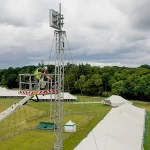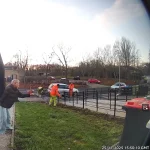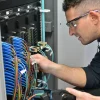BT CEO on the Full Fibre Threat from Virgin Media O2 and TalkTalk

The CEO of BT Group, Philip Jansen, has given a more detailed comment about the likely impact on their full fibre plans of broadband rival Virgin Media (VMO2) acquiring budget UK ISP TalkTalk, which he admitted would “knock off some cream of the FTTP case” but it apparently won’t “touch the fundamentals of it at all“.
Just to recap. Openreach are currently investing up to £15bn to make their Fibre-to-the-Premises (FTTP) broadband network available to 25 million UK premises by December 2026, and they’ve already completed 8 million. The operator is currently building at a pace of around 59,000 premises per week and expects to reach 10 million by the end of the year (i.e. adding 3.5 million premises in the year, which would be up from 1.9m in 2020/21).
However, the national incumbent faces growing pressure from VMO2, which is not only starting to upgrade around 15m of their existing premises to XGS-PON (10Gbps symmetric capable full fibre) technology, but also planning to roll out the same technology for up to another 7 million premises as part of a new Joint Venture (here). The latter will be offered to rival ISPs at wholesale, while their existing network is also expected to go wholesale at some point.
Advertisement
Most recently, VMO2 is also known to have proposed the £3bn acquisition of TalkTalk (here), which – if confirmed – would give the group a similar number of broadband customers to BT’s retail base of c.9-10 million; that could be used to support their own plans for wholesale. Naturally, such a prospect caused BT’s stock price to take somewhat of a hit last week, but Jansen isn’t worried.
Philip Jansen, CEO of BT Group, told investors:
“I think we’ve always assumed over the sort of 10 – 15 years of this fibre build, there will be some losses over time. So in our investment case, we made a set of assumptions around that. I guess the real answer here is the economics of this investment decision, when we took it, had a sort of wide fan of outcomes.
Obviously, the risk profile was significant. That has dramatically changed in the last 2 years. And the fact that we will have 10 million homes built in less than a year is crucial in terms of determining how we get a return. So that’s why we said today, and I said in my prepared comments, we feel very confident about making a fair return and a very good return on our FTTP investment. That’s not in doubt anymore.
The question is, can we get to the higher end of the range? And I think there are lots of situations where we do. If I take your specific, if hypothetically, [example of] TalkTalk with somebody else, [then] of course, we’d lose some lines. Of course, that might knock off some cream of the FTTP case. But it doesn’t touch the fundamentals of it at all, and the returns, by definition, will be strong, because you can imagine under all scenarios that TalkTalk business will always have a big chunk of their activity with us for obvious reasons.
So look, we’re not worried about it. Obviously, we prefer it to stay where we get the majority – the vast majority of TalkTalk business. But we can’t be complacent. It’s a competitive market out there. We’ve taken into account all the different dynamics. And on your overbuild point, right now, there’s a lot of building going out there, not that much connected.”
The need to generate take-up isn’t just important for BT and Openreach, but their rivals too, and this is where at least some of those smaller alternative networks may start to run into trouble, if they can’t convert their builds into a product that consumers adopt. Investors will be expecting a certain level of progress and if that isn’t achieved then it could impact the release of future funding etc. This is partly why market consolidation is going to become a more familiar feature in the near future.
Openreach’s take-up rate of 26%+ is very strong for an operator reaching its peak rate of build (a high build rate would normally suppress the take-up figure), although how much take-up an operator requires for an economically viable build can vary between locations. Much also depends on the methods of build, which impacts the cost of deployment (the cheaper it is to build, the more you can tolerate a lower take-up).
Building to a remote rural village may require much higher take-up (hence why commercial builds in these areas are often demand-led), while rolling out to a big city means you can survive on a lower figure because there are still lots of potential customers to go around, and all are within a smaller space. Average figures like 20%+ are often mentioned as being safe to break even, but it varies, and take-up may fluctuate over time due to competition.
Advertisement
Suffice to say, VMO2 can sidestep some of this by ensuring that they have a larger customer base to begin with, which would be ripe for conversation to the new network. Jansen is naturally playing the threat from VMO2 down, but over the longer-term there’s no guarantee that TalkTalk will always “have a big chunk of their activity” with Openreach. VMO2 would naturally want to move them away from that. CityFibre may also lose out a bit from this.
Mark is a professional technology writer, IT consultant and computer engineer from Dorset (England), he also founded ISPreview in 1999 and enjoys analysing the latest telecoms and broadband developments. Find me on X (Twitter), Mastodon, Facebook, BlueSky, Threads.net and Linkedin.
« 8000 Premises Lose Broadband After Maidstone Copper Cable Theft






















































It’s a reminder of how overly cautious BT Group have been in the past how strongly they underestimated the demand for first FTTC then FTTP.
Understandable given their position and heritage. With the many more innovative and agile altnets alongside VMO2’s full fibre ambitions and their own impressive FTTP uptake hopefully they’ll be more aggressive going forward.
It’d be great to not think of them as ‘good old BT’, the reliable lowest common denominator but an organisation willing to be close to the bleeding edge to deliver their CPs similar products to those offered by altnets.
This starts with XGSPON making an appearance sooner rather than later.
XGS-PON is any easy upgrade once the actual fibre is in the ground so I could see them upgrade areas of high usage relatively soon with XGS-PON.
@drevilbob. I’d insert the word “relatively” before “easy upgrade”. XGS-PON is certainly a lot easier than putting fibre in the ground, but there are different ways of handling such upgrades, and some can cause more disruption than others. We still don’t know precisely which approach Openreach will take.
A few years ago there was a fair bit of talk about Openreach selling symmetric packages up to 1Gbps using XGS-PON, but that seems to have been shelved, for now. But that was only for premium business customers. So far I’ve heard nothing solid about their plans for residential users.
XGS-PON bleeding edge? If you say so mate.
To me it sounds like ‘good ol BT’ are late to the game, as usual.
I have to wonder though at what speed VM will run theirs. I bet it won’t be 10G synchronous even if it’s capable of it.
I’m not sure of the relevance of GPON versus XGS-PON, but adding XGS-PON, or 25G PON, on top of GPON should be easy. DWDM systems work using banks of channel cards in bands, with 1300nm, or 1500nm, light on the client side and a spot frequency on the network side; The indvidual channel frequencies are then combined, amplified, and sent out on the TX Fibre, with the reverse on the recieve side.
Passive optical networks are basically DWDM on a single fibre with the TX and RX on different Wavelengths; As long as you feed your existing GPON through combiner/splitters, there’s nothing stopping you adding XGS-PON later, in tandem with the GPON, as long as the chosen Wavelengths dont interfere with each other. Using that method you could upgrade individual customers as required, and eventually retire GPON if it becomes redundant.
Something else to consider, the more bandwidth your customers use, the more DWDM capacity required in your core network, as well as faster more powerful switch routers. Currently, only enterprise customers require synchronous 10G, it’ll be a long time before the average residential customer require synchronous 1G, never mind 10G.
Back in the late 1990s and early 2000s, BT managed to rack up a cool £30Bn worth of debt buying out foreign mobile network joint ventures: VIAG Interkom (now O2 Germany), Telfort (now part of KPN via O2 Netherlands), ESat Telecom (now part of 3 Ireland via O2 Ireland), as well as spending money on 3G licenses. BT’s answer to this folly was demerging it’s mobile business O2 with only £500m of debt (apparently it was to give the new holding company of the O2 networks, mm02 plc a healthy balance sheet from day 1) and the BT was left to flogging off as many assets as it could. Yell, virtually all of it’s property portfolio (except BT Tower), it’s van fleet etc. So perhaps the BT of today doesn’t want to repeat the mistakes of Peter Bonfield and Iain Vallance. Although in fairness, they were mainly following what the market was telling them to do during the dotCom bubble years and were rewarded with the BT share price reaching an all time high of £15!
@mark I would agree. If they started to do that I would expect my Leased Line to be half the price it is – and then some.. In fact I would ditch it at the end of the term if anyone doing 1GBps/1Gbps came anywhere near me – Altnet or BT
“It’s a reminder of how overly cautious BT Group have been in the past”
I suspect that is not the reason, BT had a 20 year advantage to get FTTP installed and they shirked that using their defacto monopoly position because ‘who ya gonna call’.
I think they did not want to kill the eyewatering profit they made from leased lines and POT voice. Even now there are urban areas where companies who want large data transfer capability have to use lease lines when FTTP could do it BETTER for a FRACTION of the cost. The cost to the UK over the decades due to this selfish behaviour is incalculable.
VMO2 taking over TalkTalk is highly unlikely in my opinion. VMO2 have already committed much of their ongoing profits for converting from DOCSIS/HFC to a full FTTP model, where would they get the cash to purchase TalkTalk? If VMO2 had easy access to cash, then the new JV would likely have been financed through the VMO2 brand, rather than the parents setting up a seperate company with another partner.
Some will say that VMO2 could convert to FTTP on the cheap, but from previous articles it appears more likely it’ll be an evolutionary process; Probably the cheapest part of the conversion will be running the fibre through the ducts, but it appears VMO2 will then move customers on a demand basis, so they’ll have to run two networks in parallel for a prolonged period of time. I’m not sure the cost of making final connection is reported in VMO2’s cost projections, so their profits will be impacted as long as they have to maintain two networks.
Bt moving to a PON only model will reduce their operating costs massively, projected as £2.5 Billion by the end of 2025, possibly much more going forward. VMO2 and the Altnets will have their work cut out for them, as BT’s scale and low operating costs will make it difficult for others to compete on wholesale pricing. The media narrative is that BT’s pension deficit, and debt, will reduce BT’s ability to compete, but the pension deficit was reported as £1.1 Billion in the last full year results, and a third of the debt is lease liabilities that’ll reduce with the ongoing Exchange closure program.
The Altnets will be running full PON networks from the start, VMO2 will have to run two networks until the last DOCSIS customer is migrated. The Equinox offer will encourage CP’s to migrate from FTTC to FTTP asap, allowing Openreach to retire FTTC cabinets as FTTP becomes available.
I kinda assumed VMO2 would buy up some of the altnets as they go live. It would be a classic investment fund exit plan. De-risk the installation, start to demonstrate local takeup ramping up, then offer the area to VMO2. This strikes me as more of a Virgin Media tactic, and also helps them get off the ground with some new territories.
It seems madness that VM02 would start ripping out 1 gig capable lines to run FTTP down the roads. I suspect they’ll just retire these areas when the hardware is getting obsolete, perhaps upgrading the areas that classically saw ridiculous congestion during the evening times (living in a student area, I always found Virgin Media highly variable during peak times). Throwing some FTTP into the ‘easiest to build’ areas to lighten the load on the copper cables would make a certain amount of sense from a technical POV.
It is quite interesting using the thinkbroadband map and checking the lack of overlap between “Virgin Media” and the “AltNets” on the map @ https://labs.thinkbroadband.com/local/index.php?tab=2&election=1#9/51.8154/-0.6111/altfttp/
VM isn’t going to rip out a perfectly good HFC or RFoG network just because it’s also made an area capable of XGS-PON. What is more likely is that 1Gbps will continue to be the maximum download speed for HFC and RFoG and something higher, e.g. 1.5Gbps download or 1Gbps symetrical will be for XGS-PON. So, customers who order 1.5Gbps will have it with fibre run to their premises if necessary. It’s also entirely possible that an HFC area which is struggling to handle congestion will be migrated to XGS-PON.
My belief is that the HFC and RFoG networks will run alongside XGS-PON for a long time. If VM were to do a quick migration to XGS-PON an insane number of people will have to be recruited and trained to do the work including swapping out ONTs, and I just don’t see that happening.
How about offloading some of your salary Mr Jenson and passing it onto the lower level workers or to charity, surely u dont need to pay millions to put someone in an office all day giving orders, How about getting off you backside and going down the streets and to workers and people and talk to the common man and get an idea of whats really happening out their and what the priorities are. This is just a starters comment i could rabbit on more, but i’ll leave it at that.
Who cares about BT Group? They are far expensive ISP. But I do think VMO2 taking over TalkTalk is very UNLIKELY happen.
Given BT Group own and operate the network up to TalkTalk’s equipment in the exchange that your service runs over it’s probably a good idea to have at least some interest. The group includes Openreach.
You don’t seem to understand how broadband works in this country. BT Group own Openreach.
If we are hearing about it now, it will be pretty far along, and it’s a good way of expanding the network. It’s makes those network expansions of VMs that more cost effect with their house passed statistic’s.
I would put a £10 on it going through.
bt have too much money and they don’t even know how to use them. Whole company epic fail. Still people use copper cables in 2022 that’s a big shame.
“bt have too much money”
Have you seen their pension deficit recently? They aren’t expected to clear it until 2030.
The Government/Ofcom must split Openreach away from BT and only allow one company to provide local fibre access to the home that is open to all service providers at the same cost. Until this happens fair competition and quality service will be impossible in the UK, with rural areas dropping further behind. Why should telecoms be any different to electric or gas?
What’s wrong with an NBN like that with other networks offering other products that aren’t available on that NBN?
You seem to want to reduce choice for the 80% of the UK that’ll be passed by at least 2 networks by taking everyone down to the lowest common denominator. Why?
Economics. It is not cost effective to put in separate gas mains or separate electricity substations, but it is economically possible to duplicate fibre runs, especially where they share the same duct. You say you want “local fibre access to the home that is open to all service providers at the same cost”, good news, Openreach have to provide the exact same service at the exact same cost to any ISP, that is not the case for any other provider. As for rural areas, I think there are many that have never seen a gas main, and quite a few that don’t have mains sewerage either. Quite a few rural areas are doing much better on broadband than many town areas – it is not a simple split.
Stop what you’re doing everyone…
Looks like we can do away with Ofcom and let Deon regulate the UK telecoms market.
What a relief!
Clearly Deon knows much more about all this stuff than a regulator full of professional economists.
Better still, let’s make Deon Prime Minister.
Got any ideas on Climate Change Deon?
I’m struggling with how removing competition increases competition. Could you explain?
It seems like Bloated Toad are worried about alt networks taking business off them, as it seems all of a sudden they are here. Before zzoomm started lying fibre, I don’t think BT would have started here for a couple more years.
Zzoomm have had a good head start on Openreach and to be honest open reach don’t seem to be moving very fast, the hoops of fibre on the poles have been there for over a week and I have not seen an openreach van around here for a few days now.
They’ve been doing that nationwide. It’s completely sensible and is entirely about trying to preserve customer base.
They are likely working in phases with crews doing part of the work rather than having each pole go through all the commissioning process start to finish before moving onto the next one.
Business as usual. No desperate rush: most people are under contracts for a few months at least and their existing providers may seek to recontract them with full fibre.
If you can get it even – I couldn’t OR wouldn’t come and install FTTP as my house does not have enough Brick to be able to drill through – it seems a 12M by 5M wall is not enough to OR to use for 1 tiny pissing hole!
So I am stuck on FTTC – with leaflets coming through for 900 weekly – even my ISP offered it to me twice – and BTO came and said no twice.
So even then you never know if you will get it or not
Same happened to my street, we have had virgin for a long time but have been waiting for years to have openreach, then all of a sudden openreach was live, that was a month ago but now I had a letter about another fibre provider, ms3 solutions from Hull are doing my area now and there advertising 900 down and 900 up for £45 a month, way better than bt or virgin.
@An Engineer, Yes, most people I know are still under contract with their providers, I do know one that have not renewed and is waited out for Zzoomm, but zzoomm is now already up and running where they are, so I think they said they ordered it now. I hope zzoomm does well and people don’t get confused and think openreach is zzoomm. Not sure how many people will use the 2Gb/S Zzoomm service, £99 a month is a lot of money.
I hope Openreach is delayed for a few months at leats, just to give zzoomm time to get some customers.
It has been over a week now since I have seen an openreach van up here, even if there were in some other part of the estate I thought I would have seen their vans going up and down.
I am surprised that zzoomm have not sent any leaflets telling people what they are doing, there are still a load of people that have no idea what Zzoomm is and what it is for.
@angry man, They can’t drill because there is not enough brick? That don’t make any sense. My house is all brick a good old solid house that was built just after the war, plenty of brick, also I already have two holes that are not used now, one for the old sky dish, that I removed a few weeks ago as it has not been used for years and one for the cable that was used for the mast for my Wireless broadband. Also have a large vent that is again not required as I don’t have a gas fire any more, so that could be used.
@Peter Smith £45 a month is cheaper than zzoomm for that speed. Not that I would want that speed, if i did go for zzoomm I would go for the 150Mb/s up and down, that is £3 a month, but the first 6 months is free. But after that six months, that is still Around £9 more than what I am paying with plusnet. If they offered a slower speed for less, then I would think about it. With the way bills are increasing, certainly gas and electric, I have to watch what I speed, I am looking at subscriptions to get rid off, Audible I am going to get rid of, once I converted the tokens I have into books. I have already got rid of Amazon Music and just use the prime for music. If Netflix does stop account sharing or charge more for it, then that will go.
I can’t justify spending more on broadband for a higher speed I don’t need, and sadly I think zzoomm will find that out and also openreach.
aD47 if you looked and studied the roll out plan on openreach.co.uk it would had told you when openreach were intending to build and where — not sure what zzzzzzzzzzzzzzoooom has anything to do with it
Virgin Media extended their network using FTTP to include us 4 years ago but I never took it because of the poor upload, plus you know, it’s VM there are countless other reasons I’d avoid them even if it was symmetric.
BT customer since dial up, on FTTC for 12 years now and about to jump to cityfibre once it’s live.
Problem for BT is I don’t see anything bringing me back to them even if they do install FTTP, it’ll probably be asymmetrical and more expensive. Cityfibre will be symmetrical gigabit at £40/month. Don’t mind paying a bit more if it’s worth it but how do they compete with that. Of course quality of the connection comes into play in terms of latency and congestion but I don’t imagine that will be an issue, hope not anyway.
Once BT lose customers it could be tricky to get them back.
The bigger question how many Altnets will survive, and for how long?
History has a habit of repeating itself and the current expansion of FTTP networks is not dissimilar to the early cable expansion, except they had their own franchise areas back then. After the early years prices soon shot up, presumably to pay off the massive debts, and competition from satellite eroded their customer base.
In areas where there is only Openreach and one altnet, the altnet should do well But where there are 2 or more altnets it is unlikely to be sustainable and consolidation, and steep price rises are inevitable
I know several BT FTTP customers on the 1Gb service, they’re very happy with their speed.
@ICaras
Can confirm. BT FTTP 1gig is spot on, customer service has been spot on. I’ve changed package 3 or 4 times since signing up – all through the UK based FTTP team and I can’t fault them. (Except maybe being symmetrical would be nice..)
Virgin on the other hand (also an FTTP Line) is a complete shambles of a mess. Higher latency (18ms vs 6ms), Crap upload (50mbit vs 110) and having to deal with their customer service.
BT is expensive because they have to be to encourage competition. Look at the Market 1/2/3 exchange we used to have, BT is no stranger to area/regional pricing and if there was a competitive altnet I’m sure they’d lower their prices (if allowed to)
I know BT do a 1 gig download service, I was talking about symmetrical.
My reference to “quality of the connection” was refering to other providers, not BT, I was saying it would only be a symmetric speed and better quality connection (than the altnet I’d moved to) that would entice me back to BT. But I don’t see quality of the connection being an issue on Cityfibre (hopefully). Hence if BT lose customers because they haven’t got fibe in the ground it’d be tricky to win them back.
Your right BT may be able to drop prices here and there to compete but the fourty quid a month for symmetrical gigabit the altnets are offering is already very reasonable, not much wiggle room there I imagine unless BT want to take a loss. Plus it’s a one month rolling contract with an ISP on the cityfibre network whereas BT would be a much longer contract and the lower introductary price would most likely quickly be eroded with mid contract rises. Unless they really wanted to hold onto you you then they would have to stop that shenanigans.